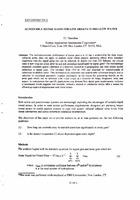| dc.contributor.author | Hanrahan, J. J. | |
| dc.date.accessioned | 2018-10-11T14:05:44Z | |
| dc.date.available | 2018-10-11T14:05:44Z | |
| dc.date.issued | 1993/08 | |
| dc.identifier | 803 | |
| dc.identifier.govdoc | CP-42/2 | |
| dc.identifier.uri | http://hdl.handle.net/20.500.12489/136 | |
| dc.description.abstract | The well-documented conformance of signal gain to a 20 log n relationship for deep water, refracted paths, does not apply to shallow water where angular spreading effects from boundary roughness limit the signal gains that can be achieved. In depths less than 200 fathoms, the central issue is how long can a line array be and still contribute significantly to signal gain. The methodology employed considers spatial coherence in a direction transverse to propagation and then relates spatial coherence to signal gain.. The literature from 1970 to 1992 was searched for measurements of coherence in shallow water. This infonnation on coherence was used to infer coherence lengths and to calculate its reciprocal parameter, angular uncertainty, as the means for generating bounds on the array gain which can be achieved with linear arrays as a function of range, frequency, area. and season. In anticipation that specific applications may demand firm signal gain requirements, evidence is introduced which suggests that multiple, vertically stacked or volumetric arrays offer a means for off-setting expected degradations with linear arrays. | |
| dc.format | 9 p. : ill., 8 fig. ; digital, PDF file | |
| dc.language | English | |
| dc.publisher | NATO. SACLANTCEN | |
| dc.source | In: Low frequency active sonar (SACLANTCEN Conference Proceedings CP-42), vol. 2, 1993, pp. D/15-1 - D/15-9. | |
| dc.subject | Sonar arrays | |
| dc.subject | Shallow water | |
| dc.subject | Signal processing | |
| dc.title | Achievable signal gains for line arrays in shallow water | |
| dc.type | Papers and Articles | |
| dc.type | Conference Proceedings (CP) | |
